Punjab - Culture - Instruments
The folk instruments used to accompany Punjabi folk music reflect a cultural contiguity extending right across the length and breadth of Asia, material proof of influences from as far away as Greece and China. Research, indicates that out of 87 instruments used by Punjab's folk musicians during the past century, 55 are still intact, 13 can be described as vanishing and 19 are long since gone. Some of these instruments survive in the folk orchestras, others have been adapted to the needs of the times. Some instruments like the taus are very beautiful but, with few players, are relegated to museums.
Dhol
Dhol is the most favourite folk instrument of Punjab. It is a percussive instrument, which is used not only with male dance performances but also on most of the social rituals and festive celebrations. The drummer is called dholi or bharai. It is a barrel shapped wooden drum with a mounted skin on both sides. It is played with two different types of wooden sticks.
 |
 |
The skin on either side is tightened at a different pitch. It is played in accompaniment with dances like bhangra and ghoomer, for munadi, at dangals, in fairs and during many social ceremonies. Some professional and traditional families of Punjab like Bharais, Dooms, Jogis and Bazigars having a long tradition of dhol-vadan are acknowledged as experts in the dhol performance.
Tumba
Toomba is a famous folk instrument of Punjab, which is entirely based on iktara (single stringed instrument) used by the legend singers. Now it has been adopted by a number of Punjabi folk singers. Though this instrument can neither produce more swaras nor is it capable of giving full octave notes, yet it has the miraculous effect of producing sound as well as rhythm simultaneously.
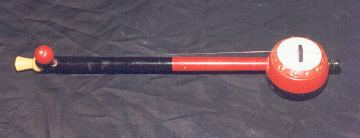
Toomba is made of wooden sticks mounted with a toomba or wooden resonator covered with skin. A metallic string is passed on the resonator over a bridge and tied to the key at the end of the stick. The artist tunes the sting according to his choice by winding up the key. The string is stuck with a finger or sometimes with the mizrab and the swaras are moulded by pressing the string to the stick. Some artists have attached electronic pick-ups to this instrument these days to produce a louder sound.
Dhad
Dhad is a small percussive instrument of the damru style. Held in one hand, it is struck on the either side, the other hand holding the skinned sides vertically or horizontally. The player keeps on tightening or loosening the strings while playing to modulate the sound.
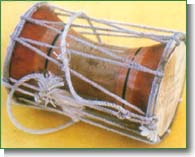 |
 |
This instrument has been very popular with the dhadies who sing traditional ballads of brave warriors and heroes drawn from history. With dhadis it is mostly accompanied by a sarangi.
Algoza
Algoza consists of a pair of wooden flutes. The algoza is also called jori (a pair) and is played by one person with only three fingers on each side. The folk singers of Punjab use algoza in their traditional legend singing like Mirza, Chhalla, Jugni etc. The instrument is also used as accompaniment with folk dances.
 |
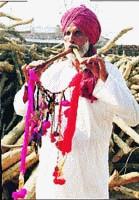 |
Chimta
This instrument is a percussive twangs type instrument used in Punjab and neighbouring areas. The tradition of playing it with songs goes back to the Naths or jogis. This instrument consists of two long flat pieces of iron with pointed ends and rings mounted on it. The joint is held in one hand, while the two parts are struck with each other for producing tinkling sounds. Chimta has become popular in professional singing and devotional music in temples.
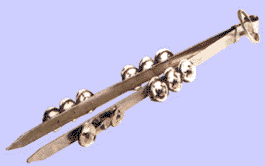 |
 |
Gharah
This simple earthen pitcher serves as a musical instrument in a number of folk songs. The gharah player strikes its sides with rings worn on fingers of a hand and also plays on its open mouth with the other hand to produce a distinct rhythmic beat.

Vanjali
Punjabis call the thin horizontally-held flute bansuri and the wider, verticary-held flute vanjali. Vansh means "cane"; a bansuri is a simple bamboo tube with an aperture to blow into and six, eight or nine holes for producing the notes.
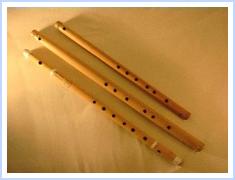 |
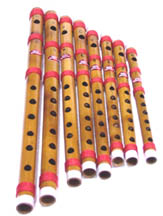 |
The first hole, three fingers from the mouthpiece, is called the mukharandhre; away from this is another hole, the nadrandre, and beyond it are the remaining holes distanced about half a finger from each other. The inner circumference is about the thickness of the index finger and the length about 18 finger- length Notes are produced by increasing or decreasing wind pressure . Ordinary pressure creates the Madhya saptak middle range while forceful pressure creates mandar saptak based notes. The bansuri may be embellished with coloured thread and tassel sometimes the pipe is bound with metal rings.
Been
This is the snake-charmer's pipe. It consists of two pipes (a drone and a chanter) made of wood, bamboo or metal set into a gourd.
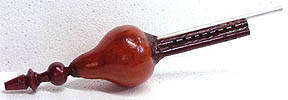
The player blows into a large opening in the narrow portion of the gourd and fingers the apertures on chanter (called the dandi) to produce the melody. Some beens do not have these apertures. Two human hairs are inserted in the pipes and attached with wax. This is a trick developed by the been players to add a hissing, snake-like sound to the instrument. Typically, the been is decorated with strings of cowri shells looped over the gourd and hanging down like tassels. Stamina and breath control are needed to become a skilled been-player.
Bagdu
The bagdu is a simple, single-note string instrument; the bowl may be made from a whole gourd or wood covered with skin. Into this sound-box is set a long stem on which the string is stretched. One type of bagdu has a thick string with a weight attached stretched from the middle of the gourd.
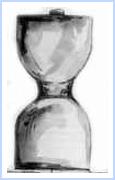
The player tucks the bowl under his armpit and, holding the weight in the same hand to keep the string taut, he plucks at the string to produce a regular humming sound. Except for folk motifs painted on the bowl, the bugdu carries little ornamentation. Once the companion of snake-charmers and sadhus, it is rarely seen these days.
Supp
A type of clapper, this instrument is seen only in Punjab. It is used in dances such as giddha, bhangra and luddi. It is made on the same lines as the cane snake, sap, a popular children's toy. Whereas the toy uses cane, the chikka sap is made of wooden sticks about a foot long and an inch wide.

Fourteen to 20 such sticks are joined lattice-fashion so that the total length is usually about one foot. By stretching and contracting the ends, the player produces a sound resembling many hands clapping in unison. A chikka-sap may be painted or left in the natural colour of the wood; it is often decorated with tassles, pom-poms and even pieces of brightly coloured paper stuck in cut-out patterns. Sometimes the pictures of movie stars are on the handholds.
Next